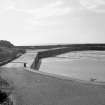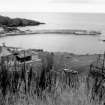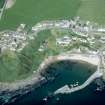Pricing Change
New pricing for orders of material from this site will come into place shortly. Charges for supply of digital images, digitisation on demand, prints and licensing will be altered.
Collieston Harbour
Harbour (Period Unassigned)
Site Name Collieston Harbour
Classification Harbour (Period Unassigned)
Canmore ID 20846
Site Number NK02NW 16
NGR NK 0406 2854
Datum OSGB36 - NGR
Permalink http://canmore.org.uk/site/20846
- Council Aberdeenshire
- Parish Slains
- Former Region Grampian
- Former District Gordon
- Former County Aberdeenshire
Collieston Harbour, 1894. Aberdeenshire's only formal link to the sea, angle granite pier and quayed shore; notable for
'tunnel piercing foundations of break-water-pier near the present end of its walkway, evidently designed for the flushing-out of silt like those recommended by Smeaton (1770) at Dundee' (A Graham). In 1696, 36 fishermen lived in 'Collestowne', one of the largest fishing communities north of the Tay; by the 1880s, there were over 100 fishing for 'prodsing speldins' (dried haddock) or 'blauvin fishies' (whiting), yet the community moved, almost wholesale, c.1900, to Torry as a result of 'the stone', an incurable malady. The Lang Reel o'Collieston used to be danced by the whole community on Forvie Sands after each fisher wedding.
Taken from "Aberdeenshire: Donside and Strathbogie - An Illustrated Architectural Guide", by Ian Shepherd, 2006. Published by the Rutland Press http://www.rias.org.uk
NK02NW 16 040 285
(Location cited as NK 041 285). 19th century. Formed by an angled granite pier and the quayed shore of a bay.
J R Hume 1977.
This place is marked by Blaeu and Groome states (1901), without quoting an authority, that in the early 19th century it was famous for smuggling. A document of 1803 supports this reputation, recording fights between preventive officers and the armed crews of luggers here and in neighbouring creeks. Otherwise the place seems to be mentioned only in 1840 when it was described as one of the two fishing villages in Slains parish, the other being Old Castle. Some old cottages, all modernised, no doubt belong to this phase of its history.
The existing harbour-works date only from 1894, but they embody a feature of some interest in connexion with harbour-construction in general, in the shape of a tunnel piercing the foundations of the breakwater-pier near the present end of its walkway and evidently designed (like those recommended at Dundee by Smeaton) for the flushing-out of silt. What are probably the remains of another such structure appear at a point further out, where the walkway is ruinous.
A Graham 1979.
J Blaeu 1654; NSA 1845; F H Groome 1901; W E Clark 1921.
(Location cited as NK 041 285). Air photographs: AAS/94/18/G38/4 and 6-9.
NMRS, MS/712/21.





































